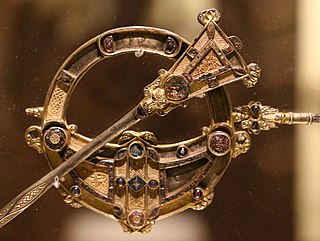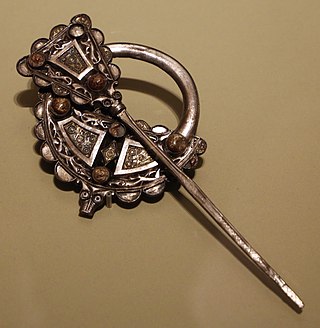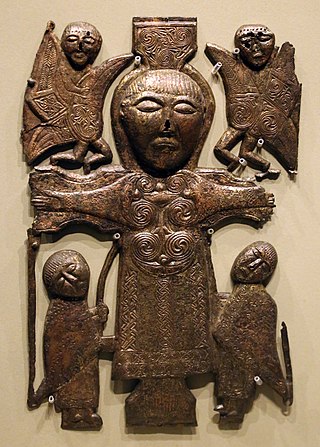List of objects
Objects for which there is a specific Wikipedia article are given in bold type.
| Image | Number | Object | Date | Location | Postage stamp | Reference | |
|---|---|---|---|---|---|---|---|
| 1 | Mesolithic fish trap | c. 5000 BC | National Museum of Ireland – Archaeology, Dublin | Set 1, 2017 (SOAR) | [3] | ||
| 2 | Ceremonial axehead | 3600 BC | National Museum of Ireland – Archaeology | Set 1, 2017 (SOAR) | |||
| 3 | Neolithic bowl | c. 3500 BC | National Museum of Ireland – Archaeology | Set 1, 2017 (SOAR) | |||
| 4 | Flint macehead | 3300–2800 BC | National Museum of Ireland – Archaeology | Set 1, 2017 (SOAR) | |||
| 5 | Neolithic bag | 3800–2500 BC | National Museum of Ireland – Archaeology | ||||
 | 6 | Basket earrings | c. 2300 BC | National Museum of Ireland – Archaeology | |||
 | 7 | Pair of gold discs | 2200–2000 BC | National Museum of Ireland – Archaeology | Set 1, 2017 ('N' rate) | ||
 | 8 | Coggalbeg gold hoard | 2300–2000 BC | National Museum of Ireland – Archaeology | Set 1, 2017 (SOAR) | ||
 | 9 | Bronze Age funerary pots | 1900–1300 BC | National Museum of Ireland – Archaeology | Set 1, 2017 (SOAR) | ||
 | 10 | Tara torcs | c. 1200 BC | National Museum of Ireland – Archaeology | Set 1, 2017 (SOAR) | [4] | |
 | 11 | Mooghaun hoard | c. 800 BC | National Museum of Ireland – Archaeology, and British Museum | |||
 | 12 | Gleninsheen gorget | c. 800–700 BC | National Museum of Ireland – Archaeology | Set 1, 2017 ('W' rate) | ||
 | 13 | Castlederg bronze cauldron | 700–600 BC | National Museum of Ireland – Archaeology | Set 1, 2017 ('N' rate) | ||
 | 14 | Iron spearhead | 800–675 BC | National Museum of Ireland – Archaeology | |||
 | 15 | Broighter boat | c. 100 BC | National Museum of Ireland – Archaeology | Set 1, 2017 (SOAR) | ||
 | 16 | Old Croghan Man | 362–175 BC | National Museum of Ireland – Archaeology | Set 1, 2017 ('N' rate) | ||
 | 17 | Loughnashade horn | c. 100 BC | National Museum of Ireland – Archaeology | |||
 | 18 | Keshcarrigan bowl | early-1st century | National Museum of Ireland – Archaeology | |||
 | 19 | The Corleck Head | 1st to 2nd century | National Museum of Ireland – Archaeology | |||
| 20 | Petrie crown | 2nd century | National Museum of Ireland – Archaeology | [5] | |||
 | 21 | Cunorix stone | 460–75 | In situ | |||
| 22 | St Patrick's Confessio | 21 | c. 460–90 | Trinity College, Dublin | |||
 | 23 | Mullaghmast stone | 500–600 | National Museum of Ireland – Archaeology | |||
 | 24 | St Patrick's bell | c. 7th century | National Museum of Ireland – Archaeology | [6] | ||
| 25 | Springmount wax tablets | late-6th century | National Museum of Ireland – Archaeology | ||||
 | 26 | Ballinderry Brooch | c. 600 | National Museum of Ireland – Archaeology | |||
 | 27 | Donore handle | 700–20 | National Museum of Ireland – Archaeology | [7] | ||
 | 28 | Book of Kells | c. 800 | Trinity College | |||
 | 29 | Tara brooch | 8th century | National Museum of Ireland – Archaeology | [8] | ||
 | 30 | Ardagh chalice | 8th century | National Museum of Ireland – Archaeology | |||
 | 31 | Derrynflan paten | late-8th century | National Museum of Ireland – Archaeology | |||
| | 32 | Moylough Belt-Shrine | 8th or 9th century | National Museum of Ireland – Archaeology | [9] | ||
 | 33 | Rinnegan Crucifixion Plaque | 8th or 9th century | National Museum of Ireland – Archaeology | |||
 | 34 | Tall cross | late-9th century | Monasterboice, County Louth | [10] | ||
 | 35 | Oseberg ship | c. 815 | Museum of Cultural History, Oslo, Norway | |||
| 36 | Ballinderry sword | mid-9th century | National Museum of Ireland – Archaeology | ||||
| 37 | Decorated lead weights | c. 900 | National Museum of Ireland – Archaeology | ||||
 | 38 | Roscrea Brooch | late-9th century | National Museum of Ireland – Archaeology | |||
| 39 | Slave chain | late-9th or early-10th century | National Museum of Ireland – Archaeology | ||||
| 40 | Silver cone | mid-10th century | National Museum of Ireland – Archaeology | ||||
| 41 | Carved crook | early-11th century | National Museum of Ireland – Archaeology | ||||
 | 42 | Breac Maodhóg | late-11th century | National Museum of Ireland – Archaeology | |||
 | 43 | Clonmacnoise Crozier | 11th century | National Museum of Ireland – Archaeology | |||
 | 44 | Cross of Cong | early-12th century | National Museum of Ireland – Archaeology | |||
| | 45 | 'Strongbow's tomb' | 12th century | Christ Church Cathedral, Dublin | |||
| 46 | Laudabiliter papal bull | 1155 | National Library of Ireland, Dublin | ||||
| 47 | Figure of a horseman | 13th century | National Museum of Ireland – Archaeology | ||||
 | 48 | Domhnach Airgid | c. 1350 | National Museum of Ireland – Archaeology | |||
 | 49 | Waterford charter roll | 1215–1373 | Medieval Museum, Waterford | |||
| 50 | Two coins | 1280s and 1460 | National Museum of Ireland – Decorative Arts and History | ||||
 | 51 | Processional cross | 1479 | National Museum of Ireland – Archaeology | |||
| 52 | Magi Cope | c. 1470 | Medieval Museum, Waterford | ||||
 | 53 | De Burgo-O'Malley chalice | 1494 | National Museum of Ireland – Decorative Arts and History | |||
 | 54 | Kavanagh charter horn | 12th and 15th centuries | National Museum of Ireland – Archaeology | [11] | ||
| 55 | Gallowglass gravestone | 15th or 16th century | Gaelic Athletic Association Museum, Dublin | ||||
| 56 | Book of Common Prayer | 1551 | Royal Irish Academy, Dublin | ||||
 | 57 | Salamander pendant | c. 1588 | Ulster Museum, Belfast | |||
| 58 | Morion | late-16th century | National Museum of Ireland – Decorative Arts and History | ||||
| 59 | Leac na ríogh | 10–15th century | Near Cookstown, County Tyrone | ||||
| 60 | Wassail bowl | late-16th century | Ulster Museum, Belfast | ||||
| 61 | Deposition on atrocities | 1641 | Trinity College | ||||
| 62 | O'Queely chalice | 1640 | National Museum of Ireland – Decorative Arts and History, Dublin | ||||
 | 63 | Fleetwood cabinet | c. 1652 | National Museum of Ireland – Decorative Arts and History (now National Gallery of Ireland) | |||
| 64 | Books of Survey and Distribution | mid-17th century | National Archives of Ireland, Dublin | ||||
 | 65 | King William's gauntlets | c. 1690 | National Museum of Ireland – Decorative Arts and History | [12] | ||
 | 66 | Crucifixion stone | 1740 | National Museum of Ireland – Decorative Arts and History | [13] | ||
| 67 | Conestoga wagon | 18th century | Ulster American Folk Park, County Tyrone | ||||
| 68 | Wood's halfpence | 1722 | National Museum of Ireland – Decorative Arts and History | ||||
| 69 | Dillon regimental flag | 1745 | National Museum of Ireland – Decorative Arts and History | ||||
| 70 | Rococo candlestick | c. 1745 | National Museum of Ireland – Decorative Arts and History | ||||
| 71 | Engraving of linen-makers | 1782 | Ulster Museum, Belfast | ||||
| 72 | Cotton panel | 1783 | National Museum of Ireland – Decorative Arts and History | ||||
| 73 | Pike | 1798 | National Museum of Ireland – Decorative Arts and History | ||||
| 74 | Act of Union blacklist | early-19th century | National Library of Ireland | ||||
| 75 | Penrose decanter | late-18th century | National Museum of Ireland – Decorative Arts and History | ||||
| 76 | Robert Emmet's ring | 1790s | National Museum of Ireland – Decorative Arts and History | ||||
| 77 | Wicker cradle | 19th–20th centuries | National Museum of Ireland – Decorative Arts and History | ||||
| 78 | Daniel O'Connell's 'chariot' | 1844 | Caherdaniel, County Kerry | ||||
| 79 | Stokes 'tapestry' | 1833–53 | National Museum of Ireland – Decorative Arts and History | ||||
| 80 | 'Captain Rock' threatening letter | 1842 | National Library of Ireland | ||||
| 81 | Empty cooking pot | 19th century | National Museum of Ireland – Country Life | ||||
| 82 | Emigrant's teapot | late-19th–mid-20th century | National Museum of Ireland – Country Life, County Mayo | ||||
 | 83 | William Smith O'Brien gold cup | 1854 | National Museum of Ireland – Decorative Arts and History | |||
| 84 | Parnell silver casket | 1844 | National Museum of Ireland – Decorative Arts and History | ||||
| 85 | Carlow Cathedral pulpit | 1899 | Carlow County Museum, County Carlow | ||||
| 86 | Youghal lace collar | 1906 | National Museum of Ireland – Decorative Arts and History | ||||
| 87 | Gaelic Athletic Association medal | 1887 | National Museum of Ireland – Decorative Arts and History | ||||
| | 88 | Reclining Buddha | late-19th century | National Museum of Ireland – Decorative Arts and History | |||
| 89 | Titanic launch ticket | May 1911 | Ulster Folk and Transport Museum, County Down | ||||
| 90 | River Clyde lamp | 1915 | National Museum of Ireland – Decorative Arts and History | ||||
| 91 | James Connolly's shirt | 1916 | National Museum of Ireland – Decorative Arts and History | ||||
| 92 | Rejected coin design | 1927 | National Museum of Ireland – Decorative Arts and History | ||||
| 93 | Boyne coracle | 1928 | National Museum of Ireland – Country Life | ||||
| 94 | Eileen Gray chair | 1926 | National Museum of Ireland – Decorative Arts and History | ||||
| 95 | Emigrant's suitcase | 1950s | National Museum of Ireland – Country Life | ||||
| 96 | Washing machine | 1950s | Irish Agricultural Museum, County Wexford | ||||
| 97 | Bloody Sunday handkerchief | 1972 | Museum of Free Derry, Derry | ||||
| 98 | Intel microprocessor | 1994 | National Science Museum at Maynooth, County Kildare | ||||
| 99 | Anglo Irish Bank sign | 2000–2011 | National Museum of Ireland – Decorative Arts and History | ||||
| 100 | Decommissioned AK-47 | 2005 | National Museum of Ireland – Decorative Arts and History | [14] | |||










